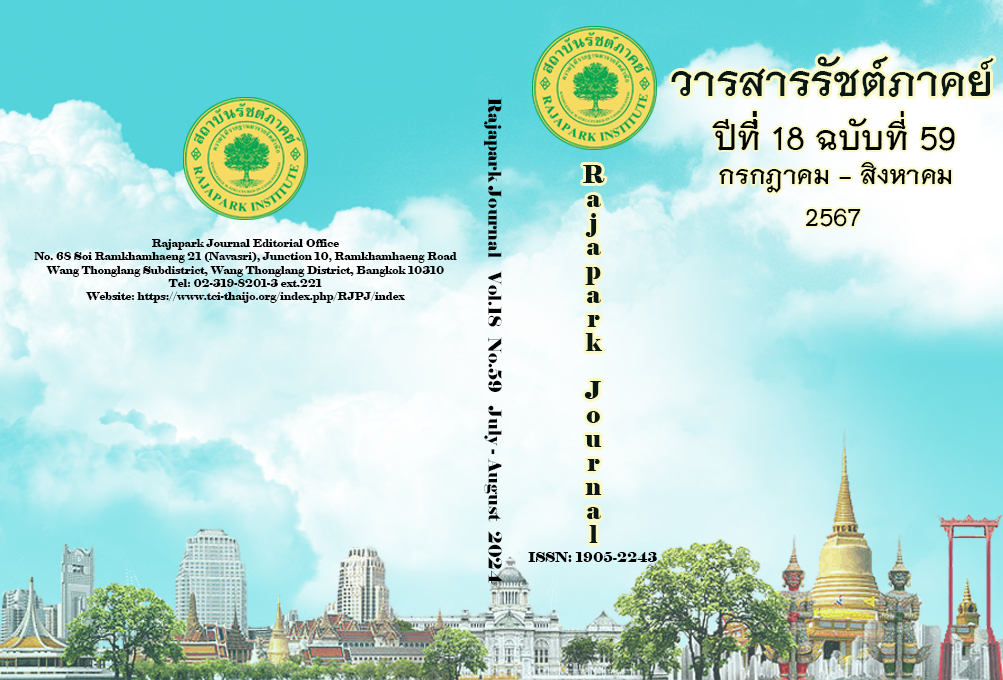The Effect of Knowledge Management Towards Work Efficiency of the Human Resources Department in an International Organization
Main Article Content
Abstract
This quantitative research aimed to study 1) the level of knowledge management of the human resources department in an international organization, 2) the level of work efficiency of the human resources department in an international organization, and 3) the correlation between knowledge management and work efficiency of the human resources department in an international organization. The sample was the employees of the human resources department in an international organization, determined through the Yamane formula with a result of 65 people. They were selected by a simple random sampling method under probability sampling. The instrument for collecting data was a questionnaire, which was assessed for reliability, resulting in a value of 0.941. The analysis of the data consisted of descriptive statistics (frequency, percentage, mean, and standard deviation) and inferential statistics which were the Pearson product-moment correlation coefficient. The research results were found as follows; 1) the overall level of knowledge management was high. Considering three main aspects of knowledge management, knowledge sharing was found at the highest level while knowledge application and knowledge creation were found at a high level, respectively, 2) the overall level of work efficiency was high. Considering four main aspects of work efficiency, they all were found at a high level, consisting of the quality of work, time, cost, and the volume of work, respectively, 3) The overall correlation between knowledge management and work efficiency was found positively high. Considering three main aspects, two aspects were found to be positively high in correlations; (1) knowledge management in the aspect of knowledge application and work efficiency, and (2) knowledge management in the aspect of knowledge sharing and work efficiency, while the correlation between knowledge management in the aspect of knowledge creation and work efficiency was found to be positively moderate.
Article Details

This work is licensed under a Creative Commons Attribution-NonCommercial-NoDerivatives 4.0 International License.
Views and opinions appearing in the Journal it is the responsibility of the author of the article, and does not constitute the view and responsibility of the editorial team.
References
Bloom, B.S. (1956). Taxonomy of educational objectives, handbook I: The Cognitive Domain. David McKay.
Brown, J., & Duguid, P. (1998). Organizing knowledge. California Management Review, 40(3), 90-111. https://doi.org/10.2307/41165945
Fahey, L., & Prusak, L. (1998). The eleven deadliest sins of knowledge management. California Management Review, 40, 265-276. http://dx.doi.org/10.2307/41165954
Garfield, S. (2014, Aug 11). 15 Knowledge management benefits. Linkedin. https://www.linkedin.com/pulse/20140811204044-2500783-15-knowledge-management-benefits/
HR Portal of the United Nations. (2015). Learning priorities: Knowledge management. https://hr.un.org/page/learning-priorities-knowledge-management
Jongjaipak, P. (2015). Knowledge management of the office of permanent secretary, Ministry of Commerce[Master’s thesis, Sukhothai Thammathirat Open University].
Khongsat, S., & Thamwong, T. (2015, Nov 25). Index of item objective congruence (IOC). Mahachulalongkornrajavidyalaya University. https://www.mcu.ac.th/article/detail/14329
Maichan, A. (2017). The factors affecting performance efficiency among employees in machine installed production LINE, Songkhla province[Master’s thesis, Prince of Songkla University]. http://kb.psu.ac.th/psukb/handle/2016/11704
Millet, J. D. (1954). Management in the Public Service. The quest for effective performance. McGraw-Hill.
Nonaka, I., & Takeuchi, H. (1995). The knowledge-creating company: How Japanese companies create the dynamics of innovation. Oxford University Press.
O’Dell, C., & Grayson, J. C. (1998). If only we know what we know: The transfer of internal knowledge and best practise. The Free Press.
Office of the Public Sector Development Commission and Thailand Productivity Institute. (2005). Manual for knowledge management plan. https://www.afaps.ac.th/kmcorner/km58/km_web/KMplanmanual.pdf
Peterson, E., & Plowman, G. E. (1953). Business organization and management (3rd ed.). Irwin.
Phanthong, J. (2019). Reliability for research questionnaire. https://www.shorturl.asia/QPzgB
Pinkesorn, K. (2021). Knowledge sharing. School of Management Science, Sukhothai Thammathirat Open University. https://mgtsci.stou.ac.th/knowledge-sharing/
Policy and Quality Development, Faculty of Science of Mahidol University. (n.d.). Knowledge Management: KM. https://quality.sc.mahidol.ac.th/plan_and_policy/km/
Rehman, M., Mahmood, A.K., Salleh, R., & Amin, A. (2014). Job satisfaction and knowledge sharing among computer and information science faculty Members: A case of Malaysian Universities. Journal of Applied Sciences, Engineering and Technology, 7(4), 839-848. DOI:10.19026/rjaset.7.326
Saha, S., Thongkham, S., & Thampramual, P. (2021). Knowledge management affecting supporting staff work performance in Thepsatri Rajabhat University. Rajabhat Rambhai Barni Research Journal, 15(3), 155-164. https://so05.tci-thaijo.org/index.php/RRBR/article/view/256480
Sallis, E. and Jones G. (2002). Knowledge management in education; Enhancing learning and education. Routledge.
Thongrang, S., & Jungsuwadee, K. (2014). The factors influencing the performance efficiency of the supportive personnel of Ubon Ratchathani Rajabhat University. Ubon Ratchathani Rajabhat University. RMUIT Journal Humanities and Social Sciences, 2(1), 67-83. https://so05.tci-haijo.org/index.php/RMUTI_SS/article/view/195928
United Nations. (2016). Knowledge Management in The United Nations System. Joint Inspection Unit.
Vartiainen, M., & Vanharanta, O. (2023). Hybrid work: Definition, origins, debates and outlook. European Foundation for the Improvement of Living and Working Conditions. DOI:10.13140/RG.2.2.12847.71844
Yamane, T. (1973). Statistics: An introductory analysis (3rd ed.). Harper & Row.


